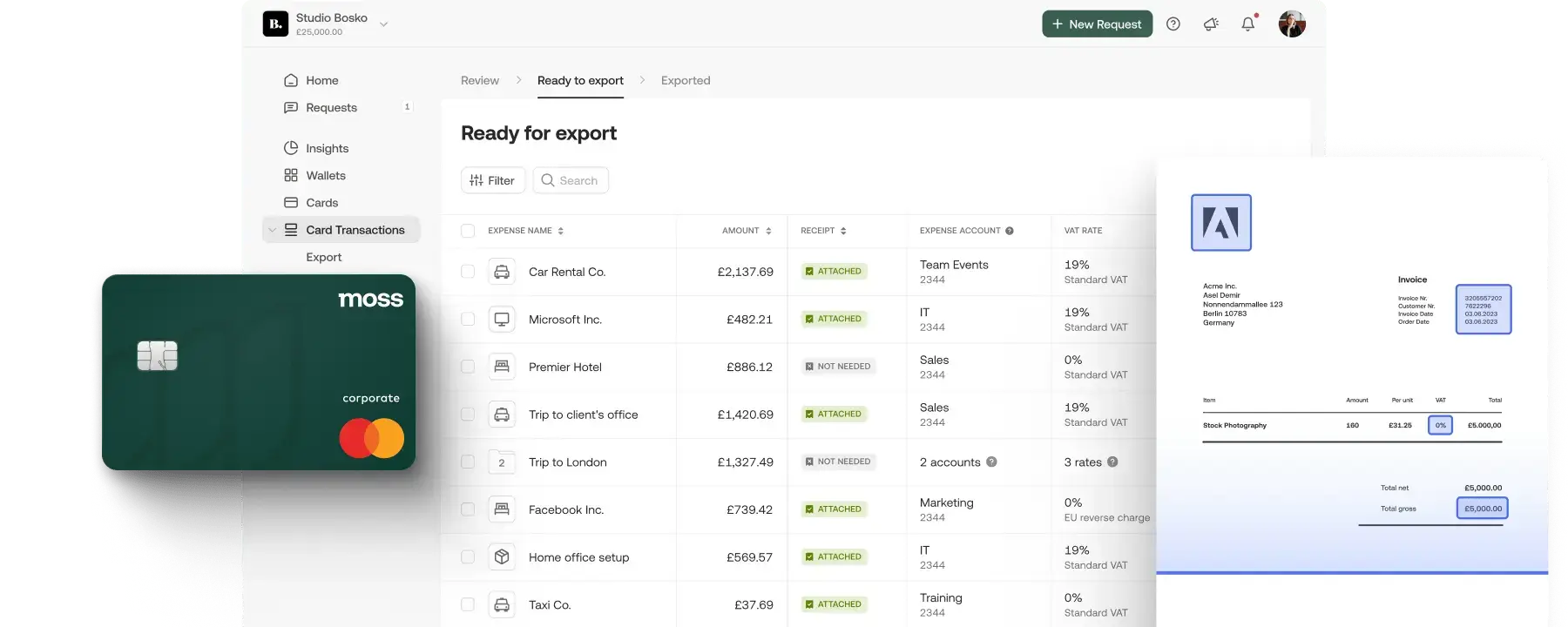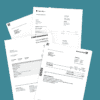On business trips, employees are often left to their own devices – and if they are not supplied with a corporate card, they usually must pay their expenses in advance. But this does not only happen when travelling on business. Reimbursement expenses occur whenever the employer refunds members of staff for their expenses. Directors can claim such expenditure as business expenses and thus they are tax-free. We provide an overview.
Reimbursement expenses: definition

Reimbursed expenses are costs incurred by employees and reimbursed by their employer. This is because it is not always possible for employees to make purchases on behalf of the company or to use its financial resources. In this case, they must first cover the expenses themselves and later have them reimbursed by the employer. This type of expenditure is mainly connected to business trips, which employees usually undertake on their own – and without access to company capital.
Five types of costs are particularly common:
- Travel expenses: On a business trip, costs are incurred for flights, train, or taxi rides, as well as for hotel accommodation or even – depending on the destination – for vaccinations.
- Meals: Restaurant visits, a snack to go, or coffee in the morning: when on the road, meals are comparatively expensive and often have to be paid for in advance by the employee.
- Transportation expenses: Not only the primary travel costs, e.g., for flights, are relevant, but also minor items such as parking fees, toll charges, or luggage storage.
- Office expenses: For employees to perform at their best, they need equipment supporting them – be it computers or, for example, high-quality office chairs.
- Communications: Communication is crucial for companies today, especially in times of remote work. To ensure that the team is always reachable, investments in communication are essential.
Reimbursement of expenses to directors
Businesses have the option to reimburse their employees for such expenses and claim them from HMRC for tax purposes. For directors, such business expenses are permissible and tax-exempt. However, if companies do not reimburse their employees, they can usually claim expenses themselves on their tax return. Many companies have introduced an expense policy so that each employee knows which expenses are covered by the employer and under what conditions.
The challenges of reimbursement expenses

Expenses and their reimbursement are a challenge for companies in many ways – either before a payment is incurred or after it has been made.
Before payment
Before making a payment with the intention of being reimbursed later by the employer, approval must first be obtained – unless there is an expense policy that clearly regulates this type of expenditure. Depending on the company structure, approval can require several days because it either involves several people or the person in charge is absent or lacks the time to approve an expense. This can inhibit corporate productivity and hamper work for employees.
After payment
Once the payment is granted, the employee must take care of the reimbursement. For business trips, this is done through a detailed expense report. In all cases, however, receipts for the payment must be provided and an explanation must be given as to why and for what the payment was made. Depending on the organisation of the company, this can be a time-consuming process – for the employee himself, for the accounting department, but also for the management. Well-defined responsibilities and structures can help to reduce the effort.
There are several potential pitfalls and difficulties here:
- The employee forgets to record payments or records them incompletely.
- The employee forgets to collect or submit the relevant receipts.
- The employee submits them only once a month or only irregularly.
- The employee does not even know which payments can be reimbursed and how to do so – because a corresponding expense policy is missing or not defined clearly enough.
- The accounting department must invest a lot of time to call in missing receipts. This means that data is obtained from different sources, which requires a lot of manual effort.
For staff, a clear procedure is crucial – this implies that such a procedure has been established in the first place and then they need to know and understand it. If companies succeed in this, they have taken an important step. Clear checklists, for example, give employees the opportunity to consult them at any time and not forget anything – small costs are often not considered, but can of course add up. And if the procedure for submitting receipts is simple, they are available to the accounting department more quickly.
How to keep track of reimbursement expenses

For employees and businesses, the key question is not which costs can be reimbursed or set off against tax liability to HMRC. After all, there are clear rules for this that you can quickly refer to. Much more important is the question of how the two parties can always keep track of their expenses – so that in the end no refundable amount is forgotten and thus no cash is lost.
For employees in particular, it can be a challenge to keep track of all their expenses. On the one hand, their business purchasing behaviour differs from their private life. On the other hand, it happens quickly that small expenses are forgotten – given their minor nature, they do not seem all that relevant at first. However, it can be even more complicated to determine what information needs to be collected about an expense and what documents need to be retained as receipts. Companies must clearly articulate and communicate these details.
For companies
For the employer, reimbursement expenses pose an even greater challenge: Especially the finance and accounting teams, which have to do the settlements month after month, are confronted with a multitude of problem sources.
Common difficulties in reimbursing expenses are:
- The data is often entered manually, which is time-consuming and prone to errors.
- Reimbursement requests may be submitted at any time and employees expect to be reimbursed quickly.
- Often the applications are incomplete or erroneous.
There are several ways to reduce such sources of error. The first and most simple step is to establish clear processes and make them easy to understand for all employees in the company – while communicating them just as clearly. For example, it can be specified at what time in the month expenses will be reimbursed – and by when applications must be submitted in order to be reimbursed by that time. In this way, employees know in advance what to expect and when, and what is expected of them.
It must be distinctly communicated which information and documents must be provided for a successful application. For this purpose, checklists can be created so that employees can check for themselves whether their information is complete – even before they submit the claim for reimbursement. This does not reduce the error rate to zero, but it does decrease it considerably.
Moreover, it is extremely helpful for the employer to automate the processes as much as possible. Expense management software is an ideal tool for this purpose. For example, it guides employees through the process of applying for reimbursements with the help of a mobile app – guided like this, they enter all the necessary information step by step and upload all the associated documents. Even easier: they can simply take a photo of their receipts and upload them directly into the app.
But perhaps the even greater added value here is for the finance and accounting teams, who no longer have to enter the data manually. Instead, the data is automatically available in the tool as soon as the employees have submitted their claims in the app. The person in charge only has to approve or reject the reimbursements – everything else happens automatically.
Automation with expense management software offers several benefits:
- It is ensured that applications are complete.
- It is easier for employees to submit claims for reimbursement.
- Claims can be approved by financial staff with one click.
- The accounting department receives applications automatically.
- The error rate is drastically decreased.
This can save employees, financial staff, and the accounting department a lot of time – time which can benefit the company in other day-to-day business areas.
Expenses handled with Moss: money back the easy way

Moss is a holistic expense solution for companies. It allows them, among other things, to reimburse expenses with just one click. Employees can simply photograph their receipts and upload them to the app – both mobile and from their desktop PC. In addition, travel data can be entered in the blink of an eye. The Moss software not only automatically prepares the claim for reimbursement for the finance department, but also calculates the per diems for the respective destination of a business trip. With one click, the claims are confirmed or rejected with a request for correction.
Once the business trip is over, the expenses are as good as reimbursed. Or companies rely on corporate cards, where employees do not have to use their own financial means at all but can have expenses debited directly from the company account. Either way, the time saved is enormous compared to the traditional procedure and compared to the expense report.
Reimbursement expenses have never been easier to manage than with Moss.
FAQs
Sometimes employees have to cover work-related costs privately first – this is often the case for business trips when they have to pay for meals or travel expenses. They are subsequently reimbursed for these costs by their employer. The employer, in turn, can claim the costs as business expenses for tax purposes.
There are different types of expenses that employees can usually have reimbursed by their employer. These are, for example, travel expenses such as flights, hotel accommodation, or additional expenses for meals – or costs for office equipment or means of communication.
For reimbursement of expenses, the details of the purchase can be recorded in a simple letter. It is important to state what was paid for, at what price, when, and on what occasion. Ideally, not only the employee number should be included but also the case number by which the expense was authorised in advance. In addition, a payment receipt is required.
The traditional process of expense reimbursement is, on the one hand, very time-consuming for the employee and, on the other hand, very susceptible to errors due to the manual entry of data. In addition, the accounting department has a lot of work with the evaluation, approval, and procurement of possibly missing receipts. In addition, the processing of applications cannot be planned, as employees can submit claims for reimbursement at any time.
With expense management software, the reimbursement process can be automated: employees can easily enter all the required information via an app and upload a simple photo of a receipt into the app. For the financial staff, the requests are automatically processed in the tool – and they can approve or reject them with one click.
Corporate cards can help to reduce the need for out-of-pocket expenses – or even make them unnecessary altogether. With the help of corporate cards, employees no longer have to pay expenses in advance and can debit them directly from the company account. Time-consuming expense reports are no longer necessary.







